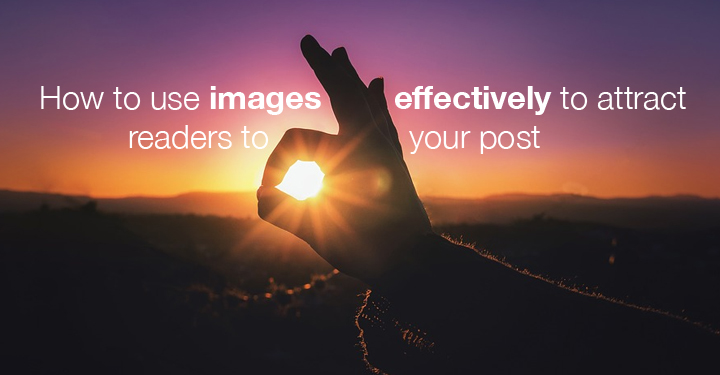How To Use Images Effectively To Attract Readers To Your Post

Knowing how to use images effectively can create a visual impact that can help towards gaining readers to your blog.
Of course you could use any pretty picture to attempt to stop your readers in their tracks. But there is so much more to consider than just selecting a relevant image and sticking it at the top of your post.
It’s definitely worth understanding how using images effectively can improve a reader’s experience. Also how this can make them continue reading to the end.
This Infographic will reveal to you the power of the picture:

More visually striking
There’s nothing more boring, or even off-putting, than a dense wall of text. Especially if there is a distinct lack of paragraph spaces and punctuating images.
However, you can make an instant improvement by how you use images effectively within your post. They provide a splash of colour inside a sea of grey words, and break up the content to make it more readable.
If you think having a pretty blog design is a good alternative, think again. It won’t be visible in blog reading lists, RSS fed links and other places where readers can find your post. Words by themselves won’t necessarily do the trick if you want your blog to stand out above the noise.
Sometimes it's necessary to visually explain your headline through effective use of imagery.Click To TweetSay more than words
Images are a great way of getting your message across, particularly to those people respond better to visual things. It’s true that “pictures can say 1000 words”, so it’s important to use images effectively to instantly portray your post’s subject.
Sometimes it’s necessary to ‘visually explain’ your headline through an effective use of images. If a passing potential reader recognises the subject of your post by glancing at the image, this will help them to understand it better before reading anything else.
Time-poor readers who scan blog contents before reading certainly appreciate relevant imagery. A brightly coloured image that catches their attention may stop them long enough to consider the post’s content and whether it is worth reading or not.
Brightly coloured images instantly make a blog post more sharable on social media platforms.Click To TweetBecome more shareable
Blog posts that take into account how to use images effectively are more likely to get shared on social media than those without. Many social media sites are programmed to work better with images. When you paste in a link into somewhere like Facebook, an image is automatically generated to accompany it.
This will instantly make your shared post more noticeable, especially if you have added a suitable featured image. But my tip would be to add in your own image to accompany your post’s URL, and disallow Facebook’s selected image. Your chosen image will have far more social reach than the version generated by Facebook’s algorithms.
Adding words to your post’s images tends to create a much bigger impact. Make sure the message you use resonates with your readers, so that they can create an affinity with your post’s subject.
If you use images effectively to tell stories, your readers will form a better impression of your blog. Make sure what you say is relevant, relatable and easily remembered, so that it can make a real difference to your readers’ lives.
Adding words to your blog's images can have a much bigger impact on your readers.Click To TweetFeed the spiders
Whenever you add images to your post, make sure they are suitably tagged if you want to benefit properly from search engine optimisation.
Remember to select your chosen keyword and include it in the alt tag behind your image. Did you know that images are invisible to the search engines and they need the alt tag to recognise them? Spiders can only read words, not pictures.
Each image also needs a valid and relevant description of its subject within both in the alt and title tags. This is because alt tags are also used by partially sighted website users’ computers. These relay the descriptions to their owners to improve their web experience while they browse the Internet.
And what about you?
What are your experiences of using images in your posts? Did you see a difference once you started to think how to use images effectively? Let me know in the comment box below, I would love to hear from you. And why not share this post with your friends on social media, so they also get a chance to have their say.
If you’d like to read other articles in this series:
Part 1, “How An Awesome Headline Can Make a Big Difference to Your Post”
Part 2: “How A Blog Post Introduction Can Make Your Readers Stay”
Part 4: “How Having A Positive Purpose Can Influence Your Blog Writing”
Sign Up For Our Mailing List
To receive more in-depth articles, videos and Infographics in your inbox, please sign up below

Sign up for the newest articles from Curatti, delivered straight to your inbox
Latest posts by Alice Elliott (see all)
- Could AI Be Better Than Humans At Recruitment? - May 23, 2023
- How The Rise of AI Affects Bloggers Socially - January 17, 2023
- How Can Twitter’s Chaos Benefit Us? #RIPTwitter - November 22, 2022
